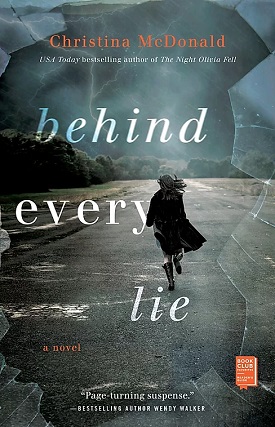 Synopsis:
Synopsis:
Eva Hansen wakes in the hospital after being struck by lightning and discovers her mother, Kat, has been murdered. Eva was found unconscious down the street, but she can’t remember what happened. But the police are suspicious of her.
Determined to clear her name, Eva heads from Seattle to London — Kat’s former home — for answers. As she unravels her mother’s carefully held secrets, Eva soon realizes that someone doesn’t want her to know the truth. As violent memories begin to emerge, Eva doesn’t know who to trust. Least of all herself.
Through Eva’s desperate search for answers and revelations about Kat’s mysterious past, Behind Every Lie explores the complicated nature of mother-daughter relationships, family trauma, and the dangers lurking behind long-held secrets.
If you can’t remember it, how do you prove you didn’t do it?
Review:

With the publication of The Night Olivia Fell, Christina McDonald became the best-selling author of a book that has been optioned by a major Hollywood studio with plans to adapt it for television. However, her “overnight success” came only after hard work and some disappointment. She holds a Bachelor of Arts in Communications from the University of Washington, Seattle, and earned a Master’s degree in Journalism from the National University of Ireland Galway. The Night Olivia Fell was actually her third novel. Neither of her first two books were sold to a publisher, but The Night Olivia Fell, written in 2015, resulted in a bidding war between two publishers and was ultimately published in January 2019. Behind Every Lie is a spectacular successor that she accurately describes as “twisty. Emotional. Empowering.”
McDonald says she gets ideas for her books from news stories that impact her. Behind Every Lie was inspired by the case of Emily Doe, the woman who was sexually assaulted at Stanford University by Brock Turner. McDonald sought to flip traditional notions of a man as “both attacker and savior, while women [are seen] as powerless, and I wanted to flip that on its head, exploring how you go on after tragedy, even when your self-trust has been eroded.” McDonald says she formulates a “basic plot idea” and “story goal,” and considers “what characters will have the most problems.” From there, “I don’t really plot anything else. I just have these general ideas and sit down and start writing from page one to the end.”
They say that behind every lie is a person and a reason.
Clearly, McDonald’s writing technique works. Behind Every Lie is an intense, atmospheric story told at a relentless pace. Once again, she mines a timeless and endlessly fascinating topic: the complex relationship between a mother and daughter. As the story opens, Eva’s memory has been impacted as a result of being struck by lightning. Ironically, that occurred on the very night her mother was brutally murdered. Now Eva can’t remember the time leading up to the murder. And because the police suspect her, she initially doubts herself, actually wondering if she was capable of such a violent, abhorrent act. She is deeply frustrated by her inability to remember. “Flashes of silvery images dances just beyond my grasp. Mom’s face. A knife. A sharp, white light. Slashes of blood.”
McDonald sets the story in two locales, Seattle, her home, and her adopted home city of London, and employs two narratives. Eva’s first-person, present-day narration alternates with that of Kat, set twenty-five years earlier. Kat notes at the outset, “A memory is no more reliable than the weather, broken, warped by the teller’s view.” McDonald deftly shows that Kat is going to explain how that opening scene in a park was “the beginning of the end,” pulling readers into a unique and cleverly-plotted mystery. Eva and Kat are the centerpieces of the tale, but McDonald includes a colorful cast of supporting characters, among them Liam, Eva’s live-in boyfriend, a successful property developer with offices in Seattle and on isolated Whidbey Island. Eva has kept a secret from Liam, and worries that if he finds out what happened four years ago, she will lose him. Because of that, Eva has isolated herself and catered to Liam’s whims, always being pliable and compliant, allowing him to dictate the terms of their relationship. Vulnerable and scarred by the events she has never revealed to him, Eva has always viewed him as a “nurturer. He like taking care of me, and I’d never minded before. In fact, maybe, — no, definitely — I’d encouraged it. He made me feel safe and cared for; it was one of the things I loved about him.” She has always believed that he is better at taking care of things than she is. There’s also Andrew, Eva’s brother, and the intriguing Lilly, Kat’s best friend. The two women grew up in England, and Lilly has been like a second mother to Eva and Andrew.
It quickly becomes clear that Eva can trust no one. Can she dare trust herself to uncover the truth? Eva, an artist, rents a small space where she sells the pottery she makes — dishware, pots, and vases. She also takes special requests from customers and employs kintsugi, the Japanese art of fixing broken pottery by filling the cracks with gold, thereby highlighting the damage rather than hiding it.
As the story progresses, everything Eva has always believed about her life and the people around her is called into question. Text messages reveal why Eva was at her mother’s home on the night she died, and a letter from her mother explains some of the truth, and the fact that Kat kept secrets from her in order to protect her.
In order to prove that she is not a murderer, she knows she must learn the truth, no matter how destructive or painful it might be. In the midst of the murder investigation, Eva flees to London in search of answers, determined not to “slink away and take the blame for something that wasn’t my fault. Not again.”
Through a series of shocking revelations, McDonald challenges readers to consider what sacrifices a mother will make to protect her child, the lengths to which a mother will go in the name of putting the child’s needs ahead of her own. She examines how several women respond to unimaginable circumstances, making choices that they will be required to live with for decades to come. And explores the impact of those choices on those whose lives are impacted. Is forgiveness too much to ask? Is it possible to move on after discovering devastating truths about your family members and their actions . . . and learn to rely upon your own power?
Behind Every Lie is a fast-moving, engrossing mystery about a woman who needs answers about who she really is not only to prove that she is not a murderer, but also to forge a future for herself, free from her family’s secrets about the past. It is entertaining and compelling, full of expertly-timed plot twists and surprises guided by McDonald’s evident compassion for Eva, her protagonist. At the beginning of the story, she is a heartbroken young woman who is very much lost, mired in mystery, memory loss, and desperately in need of information about her and her family that has been kept hidden from her for years. McDonald incorporates kintsugi to demonstrate Eva’s evolution — fixing herself internally as the story progresses just as she fixes pottery. The Japanese believe that the finished pieces becomes more beautiful than the original and when McDonald’s research revealed that to her, she “had to use it in Behind Every Lie” to demonstrate that “[w]e cab be strong and brave and broken and whole all at the same time.” Indeed, Eva’s journey to the truth, and the empowerment and belief in her own worthiness it engenders, is poignant and compelling.
Excerpt from Behind Every Lie
Prologue
WHAT HAVE I DONE?
The thought charged at me, stark and unrelenting. Blood was everywhere. Under my fingernails. In my mouth. In my hair. It was streaked across my shirt. On the floor, it blackened and congealed, filling the air with its metallic breath. The sickly sweet scent clung to the back of my throat.
My mother was slumped on the floor in the living room, mouth gaping, brown eyes staring at nothing. A dark pool of blood seeped from a gaping wound at the base of her neck. The urgent beat of her pulse had faded to an unrelenting nothingness.
Both my hands were clamped around her throat. An emotion thudded so viciously in my chest it was painful, like searing.
“Mom!” I tried to scream.
But only a choked sob came out.
Hail clattered against the windowpanes. The wind thrashed against the house. The living room lights flickered and darkened. Fear, salty on my tongue, shot through me like an electric pulse.
Suddenly I was outside, the night sky pressing on my skin.
The burning scent of ozone scorched the fine hairs of my nostrils, mingling with the pungent scent of wet earth. Black and purple clouds roiled in the night sky. Thunder rumbled ominously. The air crackled with electricity, static lifting the fine hairs along my bare arms. Rain skidded into my scalp, licking at my face.
Tears mingled with the rain on my cheeks as I ran. I was crying so hard I could barely breathe. I skirted the perimeter of the elementary school and pounded toward the park, passing cars parked neatly along the curb. In the distance, a metal statue, the Seattle skyline just beyond.
There was a massive boom, an explosion as I drew level with the statue. Then only light was all around me, inside me, crashing against my retinas, hissing along my nerves, an explosion inside my organs.
I fell to the ground spasming, crippled with pain. Fire engulfed me from the inside, every nerve ending flayed open. I was no longer in control of my brain or body. They had cracked into a million pieces.
And then there was nothing.
Blackness swallowed me whole.
Excerpted from Behind Every Lie by Christina McDonald. Copyright © 2020 by Christina McDonald. Excerpted by permission of Gallery, Pocket Books. All rights reserved.
Also by Christina McDonald:
Standalone Novels
Detective Jess Lambert Series








Comments are closed.